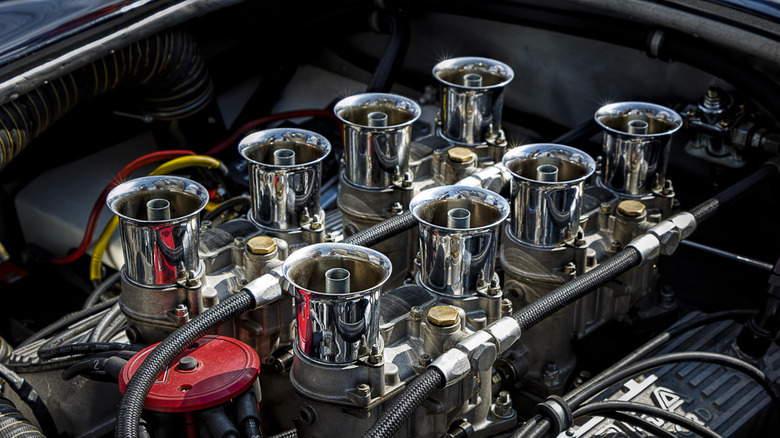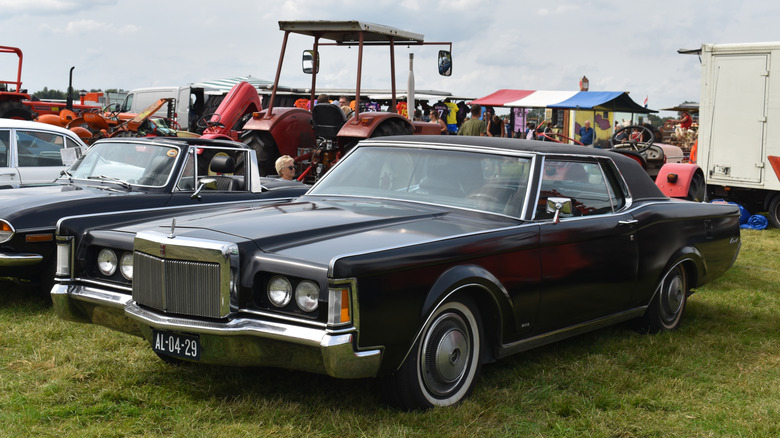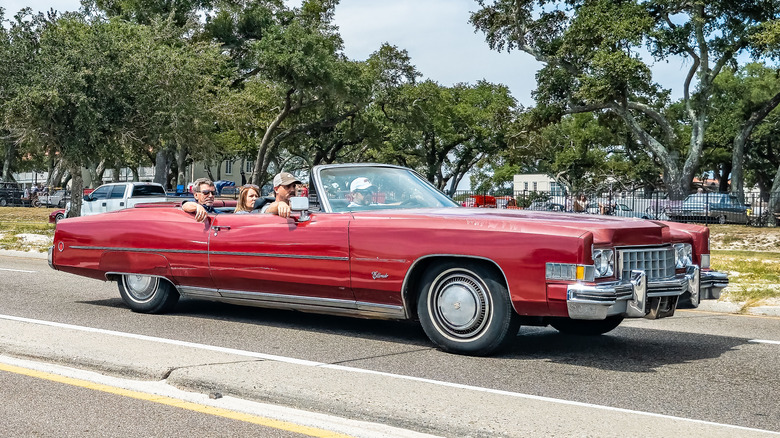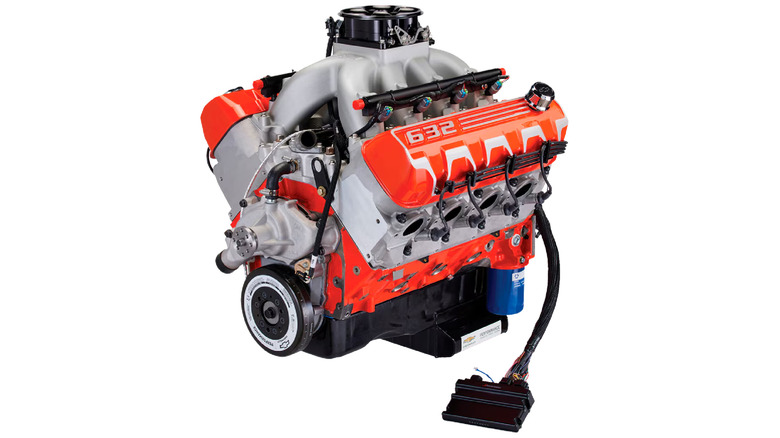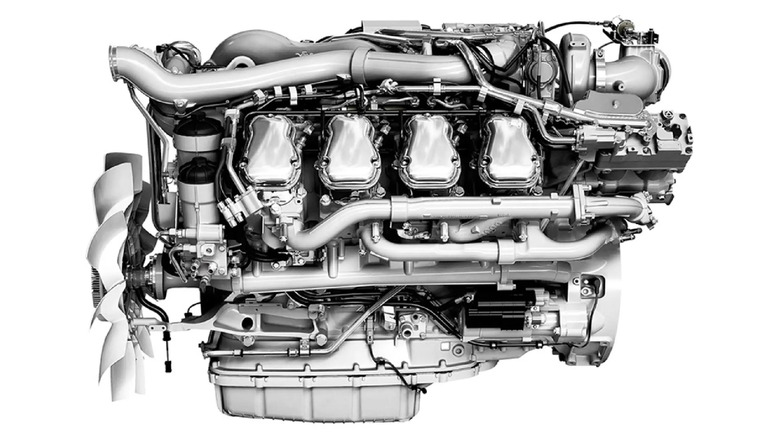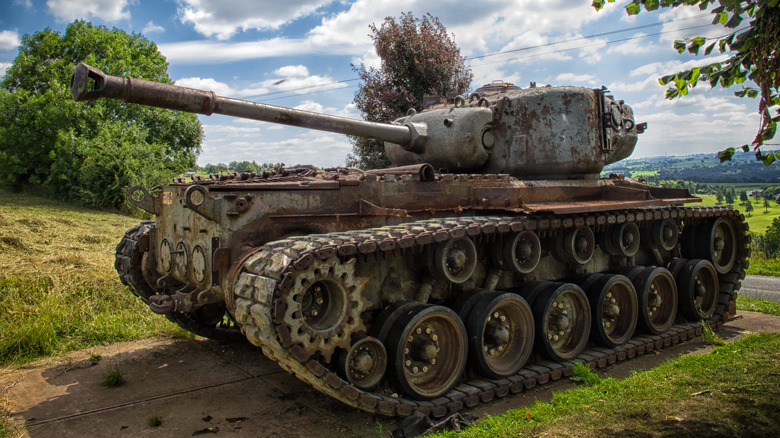5 Of The Biggest V8 Engines Ever Made
V8 engines are the soul of auto passion, and displacement has always been the most sacred measurement of these powerplants. Indeed, some readers will probably recall the famous advertisements claiming that there was "no replacement for displacement" that were everywhere in the U.S. in the 1980s. Even today, the coolest muscle cars that dare to ship with V6 engines are considered "watered down" or "tame" by many enthusiasts. But, back when the idea of the car was just catching on — before the gas crisis in America caused big block engines to go out of fashion – manufacturers were creating increasingly massive V8 engines seemingly year after year. For instance, towards the end of the 1940s, the Ford Flathead V8 was considered gargantuan; yet, by 1969, the Ford S-385 was more than 30% larger, coming in at 7.3 liters.
It was a similar scene over at other automakers, where everyone was seemingly competing to make the biggest, thirstiest engine — a situation we're unlikely to see again. And even if V8 engines aren't dead yet, they're still a far, far cry from the thundering big blocks of the glory days — when some were built for the open road, others for battlefields, and others for machinery. What unites all of them is their commitment to the fundamental principle that bigger is always better, efficiency be damned. So, with that in mind, here are five of the biggest V8 engines that humanity has ever produced.
7.5-liter Ford 460 V8 (s-385)
The first engine on our list is one of the biggest engines ever built by Ford. In the 1960s, Ford had been running with their Mercury-Edsel-Lincoln (MEL) V8 engine, but this unit was being overshadowed by Chevrolet's 7.0-liter V8, and it was time for an upgrade. As a result of this need, Ford would go on to release a new V8 engine based on the S-385 family at the end of the decade, with a monstrous displacement of 460 cubic inches, or 7.5 liters when converted.
Initially debuting in the Mk III Lincoln Continental in 1968, this engine would produce 360 hp alongside 500 lb-ft of torque, and got its name from the 3.85-inch stroke that it had. The 460 V8 would also find its way into other iconic Ford cars of the 1970s, such as the Ford Thunderbird, F-250, F-350, and even the Mercury Cougar, among others.
Though initially rated for 365 hp, as emissions laws and regulations tightened, the output for the 460 big block would drop to as low as 197 hp. That said, even in the lower-hp variants, the Ford 460 engine did retain a lot of its torque even through horsepower cuts, coming in with 362 lb-ft of torque alongside 225 hp in the mid-1980s F-250, which made it uniquely suited for pickup-truck use at the time.
8.2 liter Cadillac V8
The engine we talked about above powered the Lincoln Continental Mk III, so it is somewhat fitting that the next engine we mention powered its biggest competitor — the Cadillac Eldorado. The Caddy won on all fronts, as it made more ponies, at 400 hp; more torque, at 550 lb-ft; and had a higher top speed, at 140 mph versus the Continental's 132 mph. At the heart of all of this performance was a titanic 8.2-liter powerplant that has since become the stuff of legend. We're talking, of course, about the gigantic 500 cubic-inch V8 made by Cadillac, which, when stuffed into the Eldorado, made it one of the longest cars of all time, coming in at 221 inches long.
This gorgeous engine was deemed too regal for lesser vehicles, which is why it was exclusive to the cream-of-Cadillac's-crop Eldorado until 1975, when it was offered on other models. Furthermore, it would be several decades until Cadillac would go on to make a proper V8 — the Northstar was too unreliable, and the models powered by the GM LS V8 engine were plain boring, so it wouldn't be until the launch of the CTS-V in 2018 that Cadillac would once again be on top of their V8 game. And that's what makes the 500 cubic-inch Eldorado V8 so desirable — it was truly the last of its kind, other than being one of the biggest V8 engines that GM ever made.
10.4-liter Chevrolet V8
For those who thought the Sony WH-1000XM4 was a confusing name, we present this: the Chevrolet ZZ632/1000. Questionable naming aside, this engine remains the largest GM engine ever made, and the largest Chevrolet powerplant as well. Upon closer inspection, readers will note that the name isn't all that confusing, with the 632 being its displacement in cubic inches (which works out to 10.4 liters), and 1,000 being its approximate horsepower. We say "approximate horsepower" because, in reality, it produces slightly more, being rated at 1,004 hp and 876 lb-ft of torque.
This behemoth is based on the smaller ZZ572 unit, and is sold as a "crate engine", meaning that it arrives fully assembled and ready to install. Other notable information about the Chevrolet ZZ632 engine includes the fact that it made all of its rated horsepower on pump gas – meaning that no super-specific ethanol percentage is required for it to produce almost a megawatt of power.
Furthermore, this massive crate engine produces all that power without any forced induction, as it is a naturally aspirated unit, which makes its performance all the more impressive. It's durable too, having piston heads made from aluminum, a crankshaft made of forged steel, and a super-dense cast-iron block – it'll handle extreme stress and temperature with ease. That's why the ZZ632/1000 is popular with niche tuning shops and drag racing teams — aside from the fact that it isn't street-legal in most parts of the United States.
16.4-liter Scania V8
There comes a point when engines get so big that fitting them into a regular old car simply isn't feasible any more, so we move up a vehicle class, into semi-trucks. This next engine on our list comes from Europe — yes, Europe, home of the three-cylinder eco-pot — from Scania, in the form of their giant 16.4-liter V8. Though not quite what one would term as a "car engine" — it's still a V8, and certainly one of
the biggest engines in the world
. Used in Scania semi-rigs, which are often termed "The Rolls Royce of trucks", this V8 is actually surprisingly efficient for what it is.
Creatively named the "Scania DC16 V8", it's truly massive, coming in at approximately 52 inches long, 47 inches wide, 49 inches tall, and weighing 3,000 pounds – definitely not an engine you should attempt to put in a Mazda Miata – though someone is bound to try. Its power figures are as impressive as its size, as it produces 770 hp and 2,729 lb-ft of torque in its most performant configuration. All of this automotive goodness commands a hefty premium, for the Scania S-series that the engine is found in has a base MSRP of about $141,000 (121,000 EUR), and that's before any customization. However, seeing that Scania is one of the few companies that still ships an on-road truck with a V8 engine, it's 100% worth it.
18-liter Ford GAA V8
While this last engine is also made by the Blue Oval Ford Motor Company, its intended use was very different from the 7.3-liter that we covered above. It is the truly humungous Ford GAA V8, that was made and fitted for the Sherman tank, named after the legendary American army general, William Tecumseh Sherman. It was a 32-valve, DOHC monster that ended up being more than 5 feet long and 3 feet wide. Unsurprisingly, the unit produced a lot of torque, making over 1,050 lb-ft from just 2,200 RPM alongside a comparatively modest 500 hp, and, interestingly enough, it ran on petrol rather than diesel.
This fact, coupled with its ridiculous displacement of 18 liters, earned it the distinction of being the largest petrol V8 engine in history — a title that stands today. However, the GAA V8 was never intended to be a V8, as Henry Ford had mandated the company to design a 27-liter V12 powerplant that would outclass everything, to prepare for the inevitable Second World War. However, the military preferred the competing Allison V12, so Ford chopped off four cylinders and presented the GAA V8 for use in the Sherman tank — and the rest is history.
